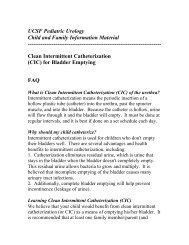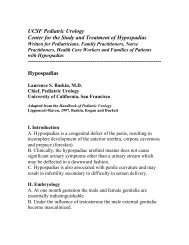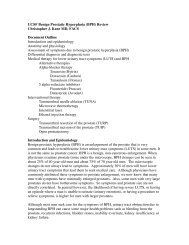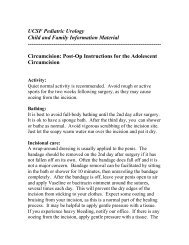Pyeloplasty Surgery for Uretero-Pelvic Junction (UPJ) Obstruction
Pyeloplasty Surgery for Uretero-Pelvic Junction (UPJ) Obstruction
Pyeloplasty Surgery for Uretero-Pelvic Junction (UPJ) Obstruction
You also want an ePaper? Increase the reach of your titles
YUMPU automatically turns print PDFs into web optimized ePapers that Google loves.
Where is the incision?<br />
The surgery can be done from a few different angles. In general,<br />
the incision will be on your child's side. Your surgeon will discuss<br />
the location of the incision that is the most appropriate <strong>for</strong> your<br />
child. All sutures are dissolvable and do not need to be removed.<br />
Occasionally there will be one skin suture removed 10 days or so<br />
after the operation if a drain left in place.<br />
Are any tubes left in place after the surgery?<br />
Different surgeons use different approaches. For example, a<br />
"stent" may be left in place to drain the ureter (<strong>for</strong> about 7 to 10<br />
days) and a nephrostomy (kidney catheter) <strong>for</strong> about 10 to 12<br />
days. A small drain (made of special, soft rubber), called a<br />
penrose drain, may be left under the incision. The tube/drains are<br />
removed in the office with minimal, brief discom<strong>for</strong>t. This is<br />
usually not painful, but may feel a bit strange. In some cases, no<br />
tubes will be left in place. Occasionally, a small amount of<br />
reddish-brown drainage may come out of the tubes/drains. It is<br />
also to be expected that the skin around the tubes/drains reddens<br />
and may have pus-like secretions around it. This is nothing to be<br />
alarmed about and is a natural reaction to the drain. Be<strong>for</strong>e you<br />
take your child home, we will help you feel com<strong>for</strong>table assessing<br />
the tube and taking care of it at home. If no drain is left in place,<br />
then the post-operative visit should be scheduled <strong>for</strong> two to four<br />
weeks after surgery.<br />
While your child is in the hospital, she/he will have a catheter in<br />
the bladder to assure that bladder and kidney are not stressed.<br />
While the catheter is in the bladder, your child may experience<br />
bladder spasms (intermittent cramping). If this occurs, your<br />
surgeon will prescribe a medication called Ditropan that will<br />
provide relief. The catheter will be removed be<strong>for</strong>e your child<br />
goes home.<br />
How long will the surgery take?










